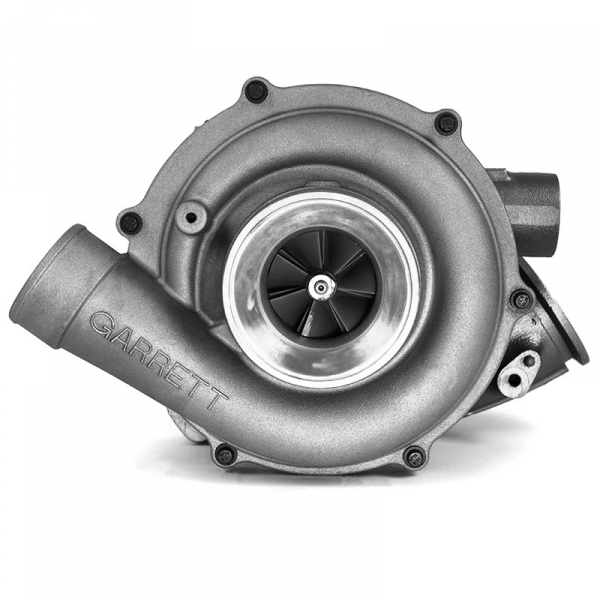
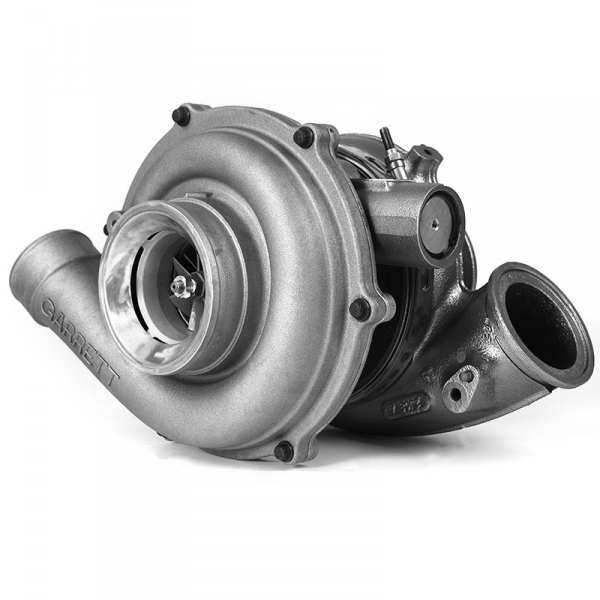
Turbochargers are standard fare on modern diesel engines. At some point, you will probably need (or want) to replace/upgrade the turbocharger(s) in your truck. Some of the turbocharger’s inner workings and specifications can be a little hard to comprehend. In this tutorial, we examine the major components of the turbocharger and some of the common terminology.
Origin of the Turbocharger
The original idea for the turbocharger can be traced all the way back to 1905. Alfred Büchi, a Swiss engineer, first patented the idea of capturing exhaust and using an axial compressor and axial turbine on a common shaft. In 1915 he created his first prototype which unfortunately failed, but this did not stop him. He continued to work on his idea for ten more years until he got it to work. Finally, in 1925 for the first time, Büchi succeeded in combining his technology with a diesel engine.
Function
The primary function of a turbocharger or “turbo” is to boost the intake air pressure of an internal combustion engine. A turbocharger consists of a compressor wheel and a turbine wheel coupled together by a solid shaft. The turbine wheel extracts energy from the exhaust gas and uses it to drive the compressor wheel. Subsequently, the compressed air is pushed out, allowing the engine to burn more fuel and ultimately produce more power.
Turbocharger vs Supercharger
So now you might be wondering, how is a turbocharger different than a supercharger? A turbocharger is powered by exhaust gas, while a supercharger is driven by the crankshaft (via a belt, gear, or chain). There are different styles of superchargers such as centrifugal, roots, and twin-screw. Regardless of the supercharger style, they are all engine-driven.
Turbochargers and superchargers both have their pros and cons. One benefit of a supercharger is that they provide boost almost instantly. Although turbo technology in recent years has really helped to offset some of the traditional turbo lag associated with turbochargers in previous years.
One big advantage of turbochargers is that it capitalizes on some of the “free” energy that would otherwise be completely lost in the exhaust. However, driving the turbine will increase exhaust back-pressure slightly, which does exert some load on the engine. The net loss still tends to be less by comparison with the direct mechanical load that is required to drive a supercharger.
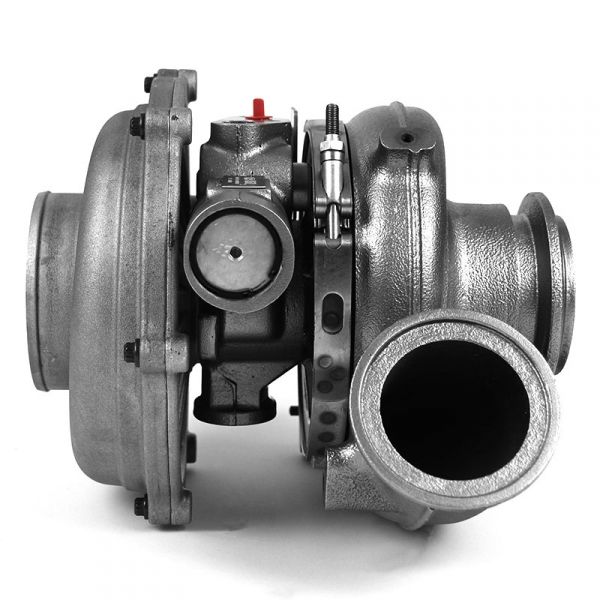
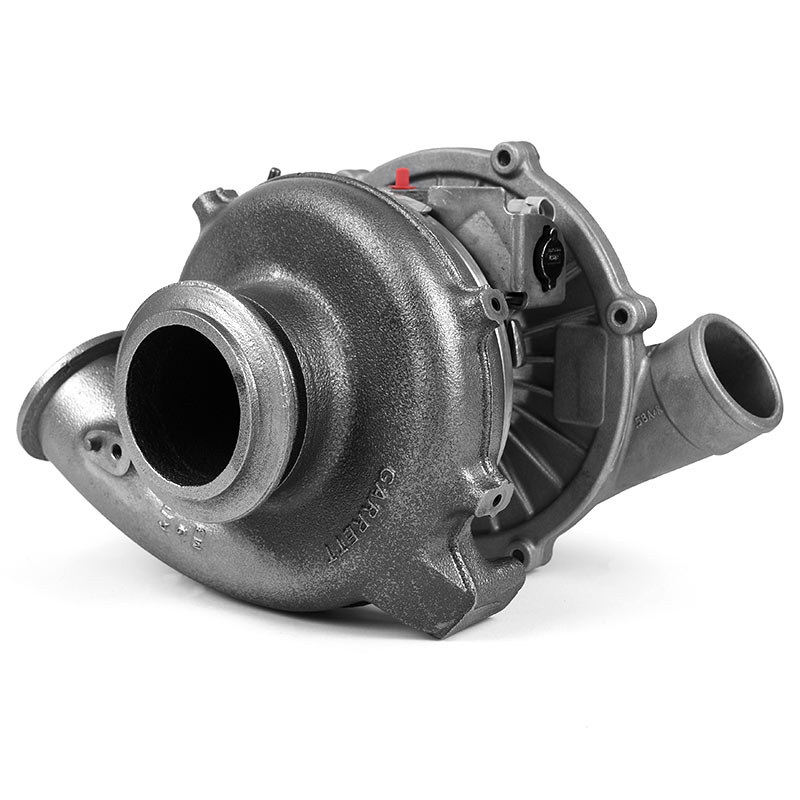
MAJOR COMPONENTS OF A TURBOCHARGER
Now let’s examine the major components of a turbocharger. The turbo can be split into three main components.
- Turbine
- Compressor
- Center (Bearing) Housing
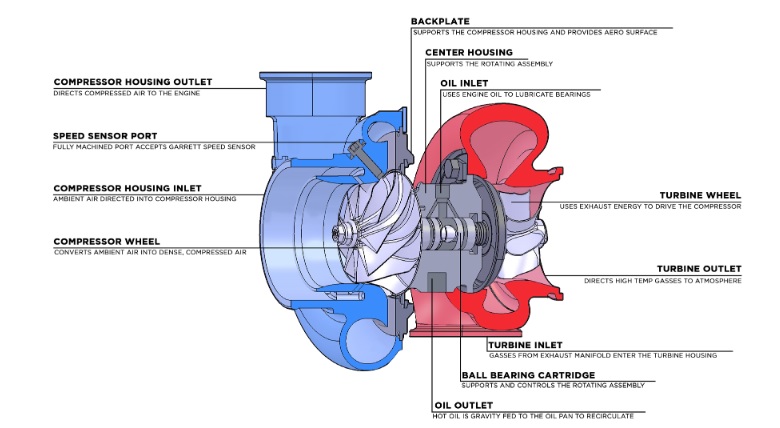
Turbine
The turbine consists of the turbine housing and the turbine wheel. In many ways, the turbine can be considered the heart of the turbocharger. The turbine housing guides the exhaust gas into the turbine wheel. The energy from the exhaust gas, in turn, spins the turbine wheel. The gas then exits the turbine housing through an exhaust outlet. The turbine extracts this energy from the exhaust to turn the compressor wheel, so the turbine is basically where it all starts.
Compressor
The compressor also consists of two parts: the compressor cover and the compressor wheel. The compressor wheel is attached to the turbine by a forged steel shaft. As the turbine turns the compressor wheel spins in relation. This high-velocity spinning draws in air and compresses it. Finally, the compressed air is pushed out, which in turn allows the engine to burn more fuel and ultimately produce more power.
Center (Bearing) Housing
The center (bearing) housing is located between the turbine and compressor and supports the rotating assembly. Located inside here is the shaft connecting the two wheels, bearings, as well as oil inlet/outlets for cooling.
Common Terminology
When shopping for a turbocharger for your truck many people can get confused by all the different terms. Let’s examine some of the most commonly talked about turbocharger terminology.
A/R
A/R (Area/Radius) is a term used to define a geometric characteristic of all turbine and compressor housings.
Ball Bearings
Steel or ceramic bearing cartridges are used in place of less expensive brass-sleeve bearings (journal bearings). Ball bearings can provide faster turbo spool-up and require less oiling pressure than stock journal bearings.
Bearing Housing
The center of the turbo that houses the turbine piston ring seal and the bearings. Utilizes pressurized oil from the engine.
Blow-Off Valve
A valve between the turbo and the intake manifold that vents air to avoid turbo surge when a preset pressure limit (boost) is surpassed.
Boost
The intake pressure created by the spinning of the compressor wheel inside the housing. Measured in pounds per square inch (PSI) over the normal atmospheric pressure (14.7:1).
Boost Controller
A mechanical or electrical device that changes the boost-pressure signal sent to actuate the wastegate, allowing higher boost pressures than would normally be permitted.
Boost Creep
When boost rises past a set limit. This is often caused by a wastegate that cannot handle the exhaust flow.
Boost Spike
A period of uncontrolled boost when the wastegate and/or blow-off valve cannot act fast enough because of sudden changes in the engine load.
Boost Threshold
When engine conditions provide enough exhaust pressure to create boost in the intake manifold.
Boreless Turbo / Wheel
A turbo that uses a compressor wheel that does not have a hole drilled through it. This increases the strength of the compressor wheel in the highest stress area.
CHRA (Center Housing Rotating Assembly)
The CHRA is the center section of a turbocharger in between the compressor and turbine housings. It incorporates the complete rotating assembly, shaft & wheel, and bearings.
Compound Turbos
Two or more turbos that feed into each other in series to build high boost pressures.
Compressor Wheel
Radial multi-bladed compressor in a turbocharger that draws in ambient filtered air, compresses it within housing, and then blows it out into the intake of the engine.
Corrected Air Flow
To plot the air flow data on a compressor map, you must ensure the flow is corrected to account for differences that affect air density, such as atmospheric conditions.
Divided Turbine Inlet
A split inside the exhaust manifold and turbine housing that separates exhaust output from cylinders to prevent turbulence based on the firing order. Also known as twin scroll.
Down-Pipe
The exhaust pipe that leads from the turbine outlet to the exhaust system under the vehicle.
Exducer
Where flow exits the turbine or compressor wheel.
External Wastgate
A wastegate that is not built into the turbo.
Free-Float
This is a turbo without a Wastegate. Therefore, the turbo is unable to regulate its own boost levels.
Impeller
Another name for a compressor wheel.
Inducer
Where flow enters the turbine or compressor wheel.
Intercooler
Air-to-air or air-to-water radiators used between the turbo and the intake manifold to reduce intake temperature, which is heated by the pressurization inside the turbo (also called aftercharger or charge air cooler).
Internal Wastegate
A built-in valve that diverts exhaust gases away from the turbine when a certain boost level is reached on the compressor side of the turbo. Can be mechanically or electrically controlled.
Journal Bearings
Fits inside the bore of the bearing housing and prevents radial movement of the shaft & wheel.
Oil Restrictor
A device that reduces the amount of oil delivered to a ball-bearing turbo because it requires less oil pressure than a stock journal-bearing unit.
Open Turbine Inlet
An exhaust manifold and turbine housing with a single opening (no divider). Also known as a single scroll.
On-Center Turbine Housings
On-center turbine housings is a turbine housing with a centered turbine inlet pad.
Overspeeding
The term used when a turbo is operating well above its normal operating limits.
Pressure Ratio
Absolute outlet pressure divided by absolute inlet pressure.
Shaft & Wheels
The complete assembly that describes the turbine wheel and shaft as one component – (Also referred to as a ‘Turbine Wheel’). It uses the exhaust flow from the engine to spin a turbine, which in turn spins an air pump.
Spool
Another term for turbo boost. A turbo is spooled up when it is creating boost in the intake manifold.
Surge
When boost pressure builds up to the point that it causes the compressor wheel to stall. This can be prevented with the use of bypass valves. Also referred to as Bark.
Thrust Bearings
A single flat bearing that supports the positive and negative axial loads generated when the turbo rotor accelerates and decelerates. The bearing is fixed, and the thrust collar runs within it. A pressurized oil film separates the ramped faces of the bearing from the journal surfaces of the collar.
Trim
The area ratio used to define the turbine and compressor wheels. To calculate the trim, you use the inducer and exducer diameters. For Example: Inducer2/Exducer2 = Trim
Turbine Wheel
A wheel that is spun by exhaust gases that pass through the fins and into the housing before dumping into the exhaust pipe.
Turbo Lag
The time it takes for a turbo to spool up after the throttle has been increased.
Twin Turbos
A system using two turbos mounted in parallel.
Up-Pipe
The exhaust pipe that connects the exhaust manifold to the turbo.
Variable-Geometry Turbo (VGT)
A turbo that uses variable vanes or a sliding nozzle to alter the volume inside the exhaust housing to maximize turbo speed at low engine rpm. Also known as variable-turbine geometry (VTG).
Variable Vanes
Adjustable blades that route exhaust gases directly into the turbine wheel at low engine rpm to increase spool on tap at low speeds.
Wastegate
Bypass that diverts excess exhaust gases away from the turbine once a preset boost level is reached in the compressor side of the turbo. It can be built into the exhaust-turbine housing (internal) or can be separate from the turbo housing (external).
